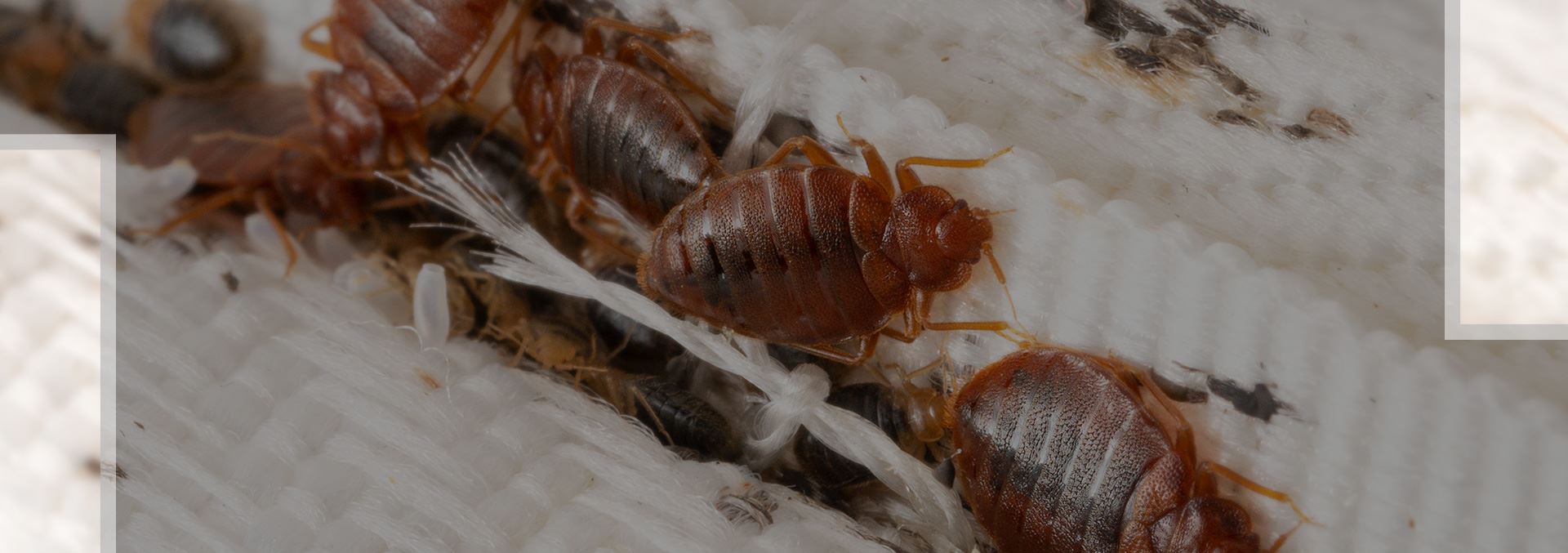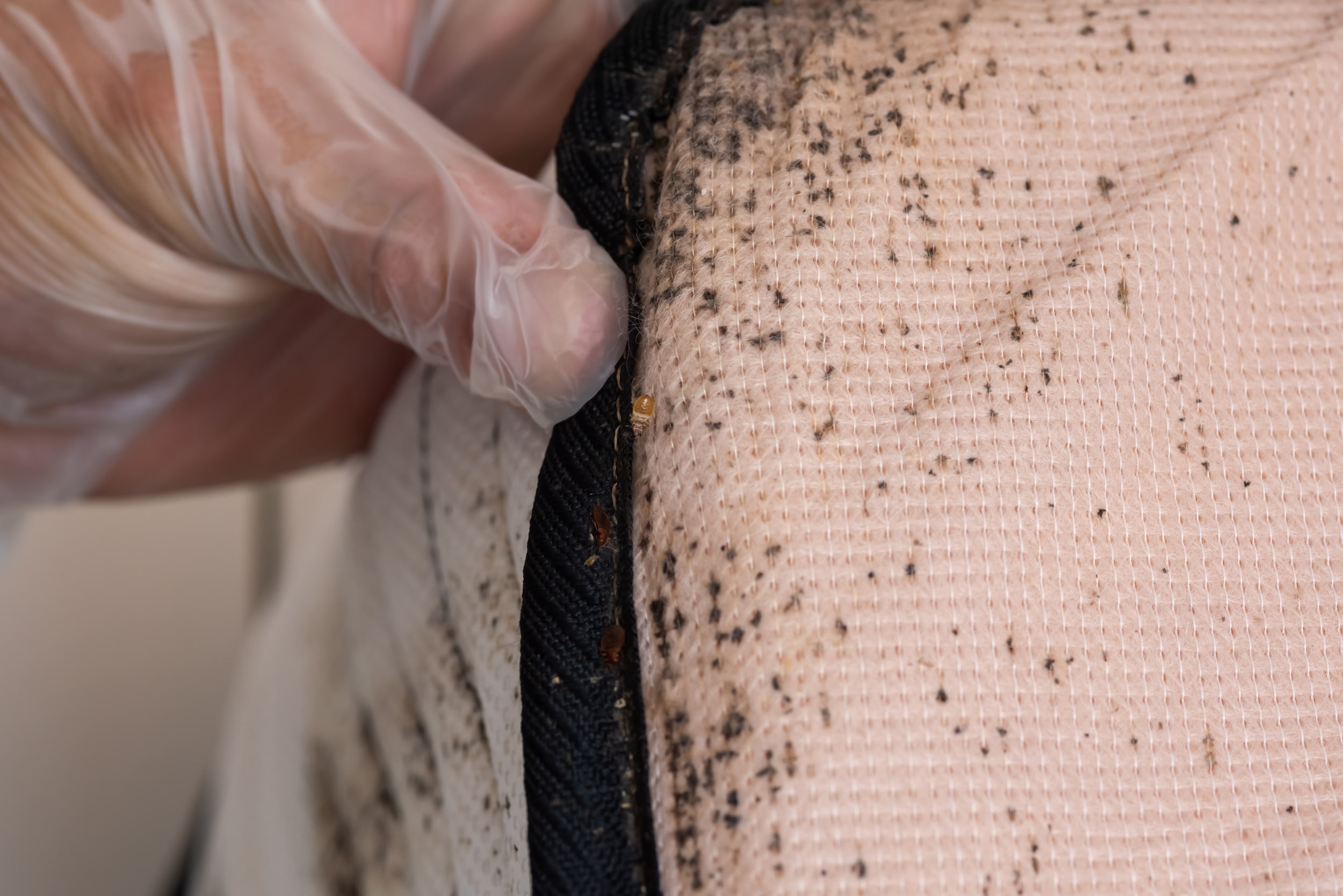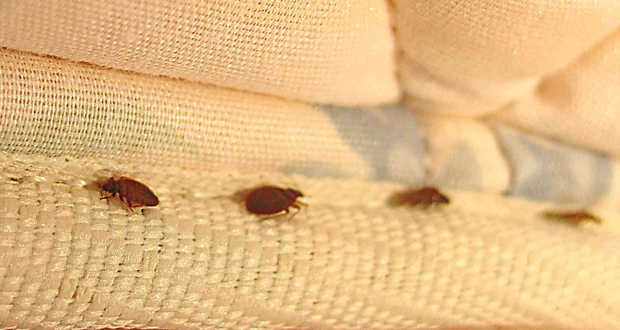Florida’s subtropical climate—featuring warm temperatures, moderate winters, and high humidity—allows pests such as bed bugs to remain active year-round. In Ocala, a city blending suburban life with equestrian charm, bed bugs can discreetly slip into homes, hotels, or short-term rentals through luggage, secondhand furniture, or daily items. If these tiny, blood-feeding insects go unnoticed, small colonies often explode into severe infestations—causing itchy bites, occupant anxiety, and potential reputational harm for businesses. This service page addresses why bed bugs flourish in Florida, how to recognize their presence, and why hiring a professional bed bug exterminator is key to removing them thoroughly.
Whether you own a single-family home in Ocala or manage properties near Summerfield, Dunnellon, or Belleview, detecting bed bugs early—and acting fast—helps you safeguard occupant well-being, curb their spread, and avoid repeated do-it-yourself efforts that often miss hidden eggs or deeper infestations.
Why Bed Bugs Thrive in Florida
Mild Winter Conditions
In colder states, subfreezing temperatures significantly reduce bed bug activity for months. Florida’s gentle cold season hardly dips near freezing, enabling bed bugs to continuously feed and reproduce indoors. Heated or air-conditioned interiors remain around 65–85°F, an ideal range for these insects to lay eggs year-round without a natural dormancy.
Frequent Movement of People and Goods
Bed bugs travel with luggage, clothing, or used furniture. Florida’s tourism, relocations, and robust local economy see consistent occupant traffic in places like Ocala or near the scenic surroundings of Summerfield, Dunnellon, and Belleview. Short-term rentals, hotels, or multi-unit dwellings with occupant turnover can inadvertently pass bed bugs from one area to the next if occupant or housekeeping checks lag.
Multiple Concealment Spots
Bed bugs slip into tight cracks: bed frames, headboards, couch seams, behind baseboards—places where occupant or staff seldom examine. During the day, they hide; at night, they emerge to feed. By the time occupant bites or dark droppings appear, a well-established colony may already occupy multiple rooms or wall voids.
Rapid Reproduction
A single female bed bug lays multiple eggs daily, each hatching within roughly two weeks under Florida’s stable warmth. Nymphs reach adulthood in about a month if no occupant or professional solutions intervene. This cycle fosters swift expansions from a few unnoticed bugs to widespread infestations if occupant detection stalls.

Telltale Signs of a Bed Bug Infestation
- Bites or Welts on Skin
- Often appearing on arms, legs, or the neck—exposed areas while sleeping—these red, itchy marks can cluster or form lines.
- Some individuals have significant reactions, while others show minimal or delayed responses, complicating early detection.
- Often appearing on arms, legs, or the neck—exposed areas while sleeping—these red, itchy marks can cluster or form lines.
- Dark Specks or Rusty Stains on Bedding
- Tiny black flecks (bed bug excrement) on sheets, pillows, or mattress seams.
- Faint reddish-brown smears emerge if bugs are crushed post-feeding.
- Tiny black flecks (bed bug excrement) on sheets, pillows, or mattress seams.
- Live Bed Bugs
- Adults measure about 5–7 mm, oval, and flat—resembling apple seeds. They redden after feeding on blood.
- Nymphs (immatures) are smaller and paler, hiding in narrow seams or cracks.
- Adults measure about 5–7 mm, oval, and flat—resembling apple seeds. They redden after feeding on blood.
- Eggs or Shedded Skins
- Pinhead-sized, whitish eggs glue to rough surfaces in seams or behind headboards.
- As nymphs grow, they leave behind translucent exoskeletons, indicating active cycles.
- Pinhead-sized, whitish eggs glue to rough surfaces in seams or behind headboards.
- Possible Musty Odor
- Significant infestations may produce a subtle, sweetish or musty scent from bed bug pheromones.
- Physical evidence—bites, excrement, or actual bugs—offers more definitive proof than odor alone.
- Significant infestations may produce a subtle, sweetish or musty scent from bed bug pheromones.
- Occupant Complaints
- In multi-room or multi-unit properties—like apartments, hotels, or short-term rentals—complaints of nighttime bites or bug sightings.
- Quick occupant or manager action blocks infiltration from one unit or room to adjacent areas.
- In multi-room or multi-unit properties—like apartments, hotels, or short-term rentals—complaints of nighttime bites or bug sightings.
Risks of Ignoring Bed Bugs
Rapid Population Boom
A single breeding female can deposit multiple eggs daily, each hatching within two weeks in Florida’s mild climate. If occupant or professional steps don’t intervene, a small infiltration multiplies swiftly into a full-blown infestation across multiple rooms.
Sleep Disruption and Anxiety
Bed bugs feed overnight, undermining occupant rest. Repeated bites foster stress or insomnia, while occupant vigilance (daily checking of bedding or furniture seams) can degrade mental well-being. For businesses or rentals, occupant unease or poor reviews may result.
Potential Spread to Adjacent Areas
In multi-room buildings—like hotels, apartments, or condos—bed bugs slip through wall cracks or occupant belongings. An initial bedroom infestation can spread widely, forcing building-wide treatments if occupant detection or staff housekeeping remain incomplete.
Greater Treatment Complexity
Minor bed bug presence, tackled swiftly, might only call for targeted sprays or simpler heat/steam methods. Waiting until bed bugs burrow behind walls or infest several rooms typically requires repeated or advanced strategies—like entire-room heat treatments—raising occupant inconvenience and cost.
Health and Reputational Impact
Though bed bugs don’t typically transmit diseases, repeated bites cause itching, possible secondary infections if scratched, and occupant stress dealing with unseen nocturnal feeders. Rental or hospitality properties facing bed bug complaints can suffer brand damage or occupant dissatisfaction if the issue persists.

Why a Professional Bed Bug Exterminator Is Key
Comprehensive Inspections
A bed bug exterminator thoroughly inspects mattresses, box springs, behind furniture, and along baseboards for droppings, eggs, or adult insects. Some rely on canine scent detection for hidden pockets. By mapping bed bug clusters, they decide whether localized or entire-home coverage is needed.
Multi-Faceted Elimination
Professionals generally combine vacuuming, steaming, insecticidal sprays, or even heat treatments, annihilating bed bugs at each life stage—egg, nymph, adult. Single-step occupant attempts (like random store-bought sprays) usually only kill visible bugs, pushing survivors deeper into cracks or wall voids.
Heat Treatments
For severe or multi-room infestations, raising indoor temperatures above ~120°F kills bed bugs and eggs inside furniture, walls, or electronics. Occupants vacate for several hours while the property is heated uniformly, with no chemical residue left behind afterward.
Chemical Insecticides
Residues placed along baseboard seams, bed frames, or furniture folds deliver lethal doses to bed bugs crossing these surfaces. If occupant sightings persist, additional spot treatments or insect growth regulators help ensure newly hatched nymphs also meet lethal conditions.
Follow-Up & Prevention
Because bed bug eggs hatch about two weeks post-laying, many exterminators return for re-check visits or remain on call if occupant sightings linger. Occupants may also be advised to encase mattresses, wash linens on hot cycles, or discard heavily infested items to stifle re-entry or movement.
Typical Methods for Bed Bug Treatments
- Inspection & Infestation Size
- Exterminators scrutinize beds, headboards, couches, or wall cracks for excrement flecks, eggs, or adult sightings.
- Determining if the issue is confined to one area or entire floors shapes whether localized or property-wide coverage is necessary.
- Exterminators scrutinize beds, headboards, couches, or wall cracks for excrement flecks, eggs, or adult sightings.
- Vacuuming & Steam
- Vacuuming surfaces picks up visible adults or eggs, reducing infestation size quickly.
- Steaming kills bed bugs at every stage on contact—effective for upholstered furniture or mattress seams without chemicals.
- Vacuuming surfaces picks up visible adults or eggs, reducing infestation size quickly.
- Chemical Sprays & Dust
- Residual insecticides or dust in cracks, seams, or behind headboards hamper bed bug movement post-treatment.
- Some professionals incorporate insect growth regulators to halt nymph development.
- Residual insecticides or dust in cracks, seams, or behind headboards hamper bed bug movement post-treatment.
- Heat Treatments
- Occupants vacate a few hours while heaters elevate interior temperatures to ~120–135°F.
- This saturates hidden corners—like wall voids or electronics—destroying bed bugs comprehensively.
- Occupants vacate a few hours while heaters elevate interior temperatures to ~120–135°F.
- Mattress Encasements
- Zippered covers trap remaining bugs inside mattresses or box springs, starving them if they can’t feed.
- Occupant checks ensure no tears or new droppings imply re-infiltration.
- Zippered covers trap remaining bugs inside mattresses or box springs, starving them if they can’t feed.
- Clutter Reduction & Laundering
- Occupants wash bedding, curtains, or clothes on high heat, then fully dry them to kill eggs or nymphs.
- Eliminating clutter denies bed bugs fresh hideouts for re-grouping post-treatment.
- Occupants wash bedding, curtains, or clothes on high heat, then fully dry them to kill eggs or nymphs.
- Re-Checks & Follow-Up
- Because eggs hatch ~2 weeks after being laid, occupant re-check or monitors under bed legs confirm newly emerged nymphs also meet lethal exposure.
- Additional spot treatments or occupant synergy finalize total bed bug elimination.
- Because eggs hatch ~2 weeks after being laid, occupant re-check or monitors under bed legs confirm newly emerged nymphs also meet lethal exposure.
- Inspection & Infestation Size

Service Area: Ocala, Summerfield, Dunnellon, Belleview
Though bed bugs adapt to various environments, this page focuses on Ocala, a central Florida city known for its equestrian roots and suburban growth. Our bed bug exterminator expertise also benefits adjacent areas:
- Summerfield: Combining rural charm with suburban expansions, occupant or staff oversight remains crucial to halting bed bug spread in busy homes.
- Dunnellon: Scenic river attractions and occupant turnover may inadvertently introduce bed bugs if occupant or manager housekeeping lapses.
- Belleview: A smaller city with close-knit neighborhoods, bed bugs can move quickly between residences if occupant awareness or property management protocols are lacking.
Florida’s mild winters allow bed bugs to feed and lay eggs all year, pressing occupant synergy plus specialized treatments for thorough eradication.
Why Choose Us
Florida-Centered Methods
We integrate recognized bed bug control approaches—vacuuming, steaming, insecticidal dusts, or entire-room heat treatments—to handle each life stage effectively in central Florida’s environment. By blending occupant housekeeping (like laundering fabrics or encasing mattresses) with advanced extermination, we deliver extended relief rather than short-term partial solutions.
Thorough Property Examinations
Before applying chemicals, technicians systematically inspect mattresses, furniture, or baseboards for droppings, eggs, and adult sightings. Mapping an infestation—one bedroom or multiple floors—drives whether localized or whole-structure coverage is ideal for occupant well-being.
Safe, Effective Solutions
Professionally regulated insecticides or dust are strategically placed where bed bugs hide, limiting occupant or pet exposure. Heat treatments saturate each corner with lethal temperatures, leaving no chemical residue behind. Occupant synergy—like discarding heavily infested items—sometimes complements these methods for full coverage.
Follow-Up & Occupant Education
Because eggs hatch in ~2 weeks, occupant re-check or scheduled visits confirm newly emerged nymphs also face lethal conditions. Occupants may be advised to wash bedding on hot cycles, vacuum floors, or seal cracks. If occupant sightings continue, additional spot treatments block any holdouts.
Timely Response & Local Expertise
Serving Ocala, Summerfield, Dunnellon, and Belleview, our staff understands the region’s occupant turnover and mild climate challenges. We respond swiftly to occupant calls, deploying flexible solutions that minimize occupant disruption while eradicating bed bugs thoroughly.
Next Steps
Waking with unexplained bites, noticing black flecks (excrement) on sheets, or spotting live bed bugs near mattresses or sofas? Contact us to learn more or schedule your service. Our bed bug treatments in Ocala, Summerfield, Dunnellon, and Belleview merge methodical inspections, integrated solutions (steam, chemicals, or heat), occupant guidance, and re-check visits—knocking out bed bugs at every stage to secure your home or business from persistent infestations.
Swift intervention spares occupant stress, prevents bed bugs from spreading behind walls, and curtails repeated occupant attempts that often focus on visible adults alone. Depend on our Florida-oriented bed bug exterminator expertise to detect, eliminate, and deter these elusive nocturnal pests, preserving occupant comfort in Florida’s mild, year-round environment.
Maintaining a Bed Bug–Free Environment
After professional treatments subdue bed bugs, consistent occupant steps prevent their return:
- Frequent Vacuuming
- Vacuum carpets, rugs, bed frames, or furniture weekly, disposing of contents outdoors in sealed plastic bags.
- This disrupts any stray eggs or nymphs that might have slipped by.
- Vacuum carpets, rugs, bed frames, or furniture weekly, disposing of contents outdoors in sealed plastic bags.
- Wash and Heat-Dry Fabrics
- Launder bedding, clothes, or curtains on hot water cycles, then dry on high heat.
- Kills eggs or nymphs clinging to fabrics, halting fresh hatches.
- Launder bedding, clothes, or curtains on hot water cycles, then dry on high heat.
- Mattress and Box Spring Encasements
- Zippered, bed bug–proof covers trap any remaining insects within, eventually starving them if they cannot feed.
- Inspect these covers for tears or new droppings indicating infiltration attempts.
- Zippered, bed bug–proof covers trap any remaining insects within, eventually starving them if they cannot feed.
- Declutter & Organize
- Piles of clothes, cardboard boxes, or random items supply extra hiding spots for bed bugs to regroup.
- Keeping floors and shelves tidy helps reveal new droppings or adult sightings before a resurgence spreads.
- Piles of clothes, cardboard boxes, or random items supply extra hiding spots for bed bugs to regroup.
- Examine Secondhand Items
- Bed bugs easily hitchhike in used furniture, mattresses, or décor.
- Check carefully for black flecks, eggs, or sheddings; vacuum or steam them thoroughly if suspicious.
- Bed bugs easily hitchhike in used furniture, mattresses, or décor.
- Seal Cracks & Gaps
- Use caulk around baseboards, door frames, or wall splits to minimize bed bug migration between rooms or units.
- Small openings let them slip in from adjacent spaces, especially in multi-unit dwellings.
- Use caulk around baseboards, door frames, or wall splits to minimize bed bug migration between rooms or units.
- Monitor Post-Travel
- Bed bugs often ride home with travelers in luggage. Inspect suitcases or clothing after trips, washing items on hot cycles.
- Early occupant detection halts introduced bed bugs from breeding unnoticed.
- Bed bugs often ride home with travelers in luggage. Inspect suitcases or clothing after trips, washing items on hot cycles.
By pairing occupant diligence—like vacuuming, laundry, and sealing cracks—with specialized bed bug treatments as required, property owners across Ocala, Summerfield, Dunnellon, and Belleview effectively counter Florida’s mild winter advantage for these pests. Despite the year-round potential for bed bugs to feed and lay eggs, occupant synergy plus professional synergy keeps them from sustaining a foothold indoors—protecting occupant health and preserving comfortable, pest-free living or commercial spaces.
